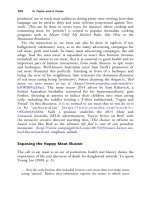The palgrave international handbook of a 341
Bạn đang xem bản rút gọn của tài liệu. Xem và tải ngay bản đầy đủ của tài liệu tại đây (27.29 KB, 1 trang )
Animal Fighting
339
cultures, with some of its most obscure forms, such as the little-known
camel wrestling for instance, dating back more than 2,400 years
(Robehmed 2014).
‘Baiting’2, an alternative term for fighting, is applied to any activity where
forced, often inter-species, combat occurs. It can take many forms but most,
such as bear-baiting, badger-baiting and bull-baiting will involve one or more
dogs trained to torment and attack the other animal (Atkinson and Young
2008). In the case of bear-baiting the teeth and claws of the bear would
usually be filed down and the animal often chained up by the neck or leg
before one or more dogs attacked. If a dog should become injured or be
killed, a replacement dog would be sent into the pit. In the UK, the very
similar activity of lion-baiting was popular from the times of James 1 in the
1600s until public outrage saw the last of this sport in 1825 (Hone 1826,
p. 499; Waters 2013). Bull-baiting too enjoyed widespread popularity in
Britain during the same period. Many of these sports would attract royal
patronage and dedicated amphitheatres, pits or arenas called ‘bear-gardens’
(Elmes 1831).
Cockfighting is also considered to date from antiquity, being possibly
one of the more global of the animal fighting sports. Some reports claim it
has roots before 2000 BC but certainly the first recorded cockfight in
China dates back to 517BC (Dundes 1994, p. 242). This ‘sport’ sees two
roosters or ‘gamecocks’, bred for their stamina, strength and natural
aggression to other males, pitted against each other in a ring or ‘cockpit’.
For increased entertainment the birds are sometimes fitted with metal
spurs, called ‘gaffs’, upon their natural spurs to ensure blood is drawn,
although that is often the outcome without such additional aids. Not every
fight will result in the death of a bird but they will usually sustain
significant physical trauma. The breeding, housing and training of these
birds is highly structured and can even involve the use of performance
enhancing or illegal drugs to aid their capacity to fight in the pit (Merck
2013, p. 250).
In the UK, cockfighting should not be dismissed as an obsolete sport,
rather, the Royal Society for the Prevention of Cruelty to Animals’
(RSPCA) database reveals an increase in reports on cockfighting from
2
In the UK the term was specified in law as an offence within section 1.1 of the 1911 Protection of
Animals Act, see This was then superseded by the
Animal Welfare Act 2006 which does not employ this term. Elsewhere baiting is defined in more detail
within legislation, see o/statute/sc-dogfighting-chapter-27-animal-fightingand-baiting-act









